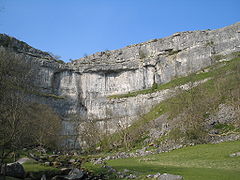Malham Cove
| Malham Cove | |
|---|---|
 |
|
|
|
|
| OS grid reference | SD896639 |
| Coordinates | 54°04′15″N 2°09′31″W / 54.070833°N 2.158611°WCoordinates: 54°04′15″N 2°09′31″W / 54.070833°N 2.158611°W |
|
|
Malham Cove is a limestone formation 0.6 miles (1 km) north of the village of Malham, North Yorkshire, England. The large, curved feature was formed by a waterfall carrying meltwater from glaciers at the end of the last Ice Age more than 12,000 years ago. Today it is a well-known beauty spot within the Yorkshire Dales National Park. A large limestone pavement is above the cove.
The cove was formed by a large Ice-age river that fell at this point as a cataract. The water drop was 80 m (260 ft) high and more than 300 m (980 ft) wide. The colossal amount of water flowing over the waterfall created the curved shape of the cove because the lip was more heavily eroded than the sides.
Today the water course is marked by a stream that flows out of Malham Tarn 1.5 mi (2.4 km) north of the cove. It becomes a subterranean stream at 'Water Sinks' about 1 mile (1.6 km) before the top of the cove. Another stream named Malham Beck emerges from a cave at the bottom of the cove. The two streams were once thought to be one and the same. However, experiments with dyes have shown that they are two separate waterways that go underground at different locations. Their paths cross without mixing behind the limestone cliff re-emerging a few miles apart. The experiments show that there is complex system of caves and tunnels within the limestone cliff. The system is estimated to be about 50,000 years old. Cave divers, entering the system through the cave at the base of the cove, have so far explored about 1 mi (1.6 km).
The cave systems usually carry away any waters before they reach the fall; however, Malham Cove temporarily became a waterfall for what is believed to be the first time in centuries on 6 December 2015, after heavy rainfall from Storm Desmond.
The priest and noted antiquary, Thomas West described the cove in 1779 as, "This beautiful rock is like the age-tinted wall of a prodigious castle; the stone is very white, and from the ledges hang various shrubs and vegetables, which with the tints given it by the bog water. & c. gives it a variety that I never before saw so pleasing in a plain rock."
...
Wikipedia

